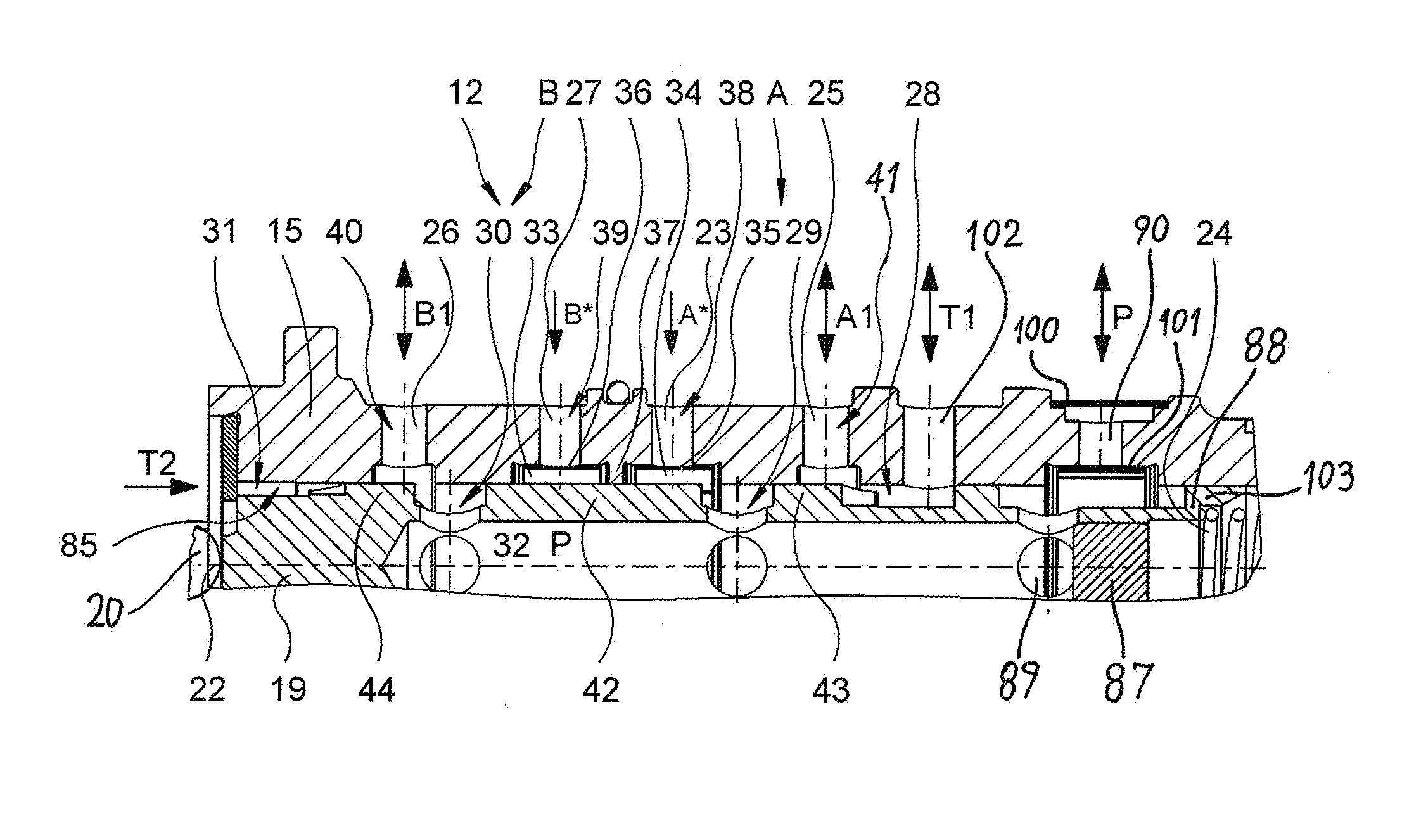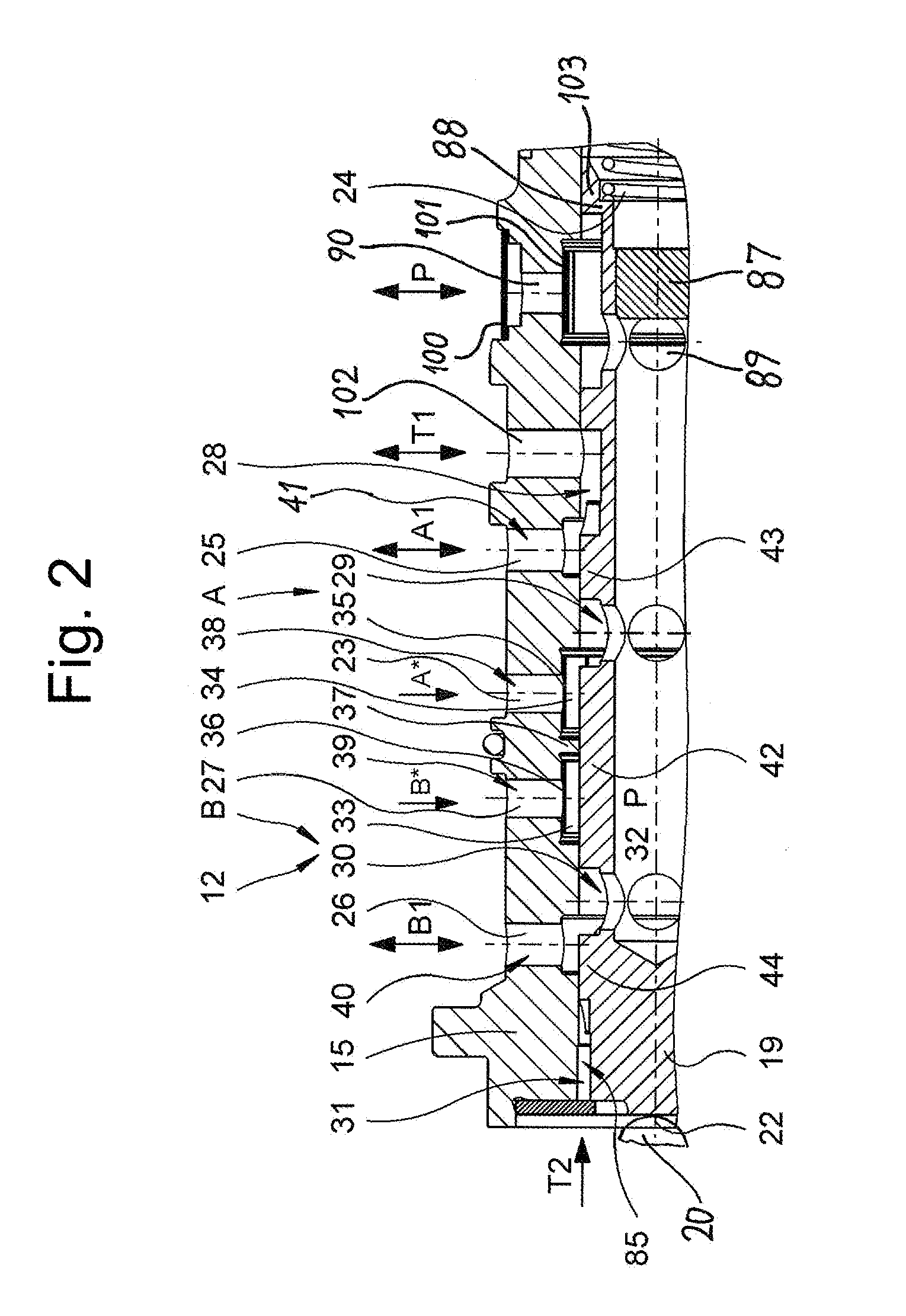[0019]According to one
advantage of the invention, the hydraulic valve of the oscillating motor adjuster is designed as a central valve. Such a central valve has advantages relative to structural space. In addition to central valves, there are also decentralized or external hydraulic valves for actuating the oscillating motor adjuster. In the case of the external hydraulic valve, the hydraulic channels for the camshaft adjustment run from the oscillating-motor camshaft adjuster to a separate timing gear cover with the hydraulic valve screwed therein or, alternatively, to the
cylinder head having the hydraulic valve screwed therein. Conduction losses accompany the hydraulic lines from the oscillating motor adjuster to the external hydraulic valve. The controls from the external hydraulic valve are also not as dynamically reactive as in the case of the central valve. The hydraulic central valve is also radially disposed within the rotor hub of the oscillating motor adjuster.
[0020]If the hydraulic valve is designed as a central valve, then the axial fixation of the hydraulic valve opposite the camshaft can be designed as separate from the axial bracing of the rotor against the camshaft. In comparison to central valves, which are also central screws, this makes possible a large play in the configuration without taking into consideration structural mechanical problems. Therefore, high-strength material need not be used. For example,
light metal, in particular aluminum, can be applied as the material. Also,
hydraulic control edges can be accurately designed on the central valve. Sealing rings, in particular O rings, for bridging the gap can be dispensed with. Since a large
screw head on the central valve is not necessary, the central valve can be manufactured with a relatively uniform outer
diameter, so that only a relatively small amount of material needs to be used, which makes the central valve cost-effective. In order to join the rotor to the camshaft in a torsionally rigid manner, the rotor can be welded on or can be pressed on with a micro-
serration. In one possible configuration, it is also possible to clamp the rotor axially with a nut against a shoulder on the camshaft. The nut can thus be screwed onto an outer thread at the end of the camshaft. The nut keeps the central valve free from stresses.
[0021]In a further possible configuration, the
piston is completely pressure-equilibrated.
[0022]The camshaft can be designed in particular as a built-in camshaft. Such built-in camshafts comprise a hollow tube, onto which the cams are shrunk-fit. These built-in camshafts are cost-effective and lightweight.
[0023]In one example embodiment of the invention, the hydraulic valve is inserted as a central valve inside the rotor. Thus, since the paths between the hydraulic valve and the pressure chambers are very short, such a hydraulic valve has advantages in its effectiveness and dynamics. Advantages relative to structural space are also achieved. If the central valve is designed as a central screw, it must be dimensioned appropriately, in order to take up the stresses for clamping the rotor. With the present invention, the central valve may also be inserted inside the rotor if the camshaft lies in between as a hollow shaft.
[0024]In a further example embodiment of the invention, recesses that have several functions for conducting the
hydraulic fluid are provided in the displaceable
piston. The recesses conduct the
hydraulic fluid from a supply channel inside the piston into the working chambers. These recesses also conduct pressure peaks that result from camshaft alternating torques from the working chambers into the supply channel. These recesses, however, are not provided for
discharge of
hydraulic fluid to the tank outlet. These recesses may have annular grooves, for example, so that the piston does not need to be oriented at an angle opposite the borehole or the bush. Such an annular groove for the distribution of the hydraulic fluid over the periphery, however, can also be worked into the inside wall of the bush.
 Login to View More
Login to View More  Login to View More
Login to View More 


